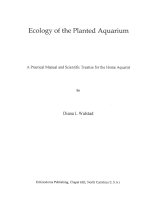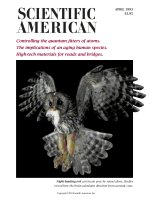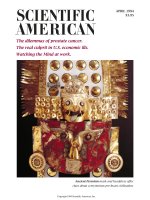the scientific american book of projects for the amateur scientist - c stong (simon and schuster, 1960)
Bạn đang xem bản rút gọn của tài liệu. Xem và tải ngay bản đầy đủ của tài liệu tại đây (20.74 MB, 605 trang )
THE
SCIENTIFIC
AMERICAN
BOOK OF PROJECTS FOR
NEW YORK I960
SIMON AND SCHUSTER -%^
l
m
E
AMATEUR
SCIENTIST
Experiments and constructions, challenges and
diversions in the fields of Astronomy, Archaeol-
ogy, Biology, Natural Sciences, Earth Sciences,
Mathematical Machines, Aerodynamics, Optics,
Heat and Electronics. Selected from Mr. Stong's
clearing house
of
amateur activities, appearing
monthly
in
SCIENTIFIC AMERICAN,
and ex-
panded with additional information, instruc-
tions,
notes, bibliographies
—
and postscripts,
from readers.
BY
C. L.
STONG
INTRODUCTION
BY
VANNEVAR BUSH
ILLUSTRATED
BY
ROGER HAYWARD
ALL RIGHTS RESERVED
INCLUDING THE RIGHT OF REPRODUCTION
IN WHOLE OR IN PART IN ANY FORM
COPYRIGHT © I960 BY C. L. STONG
PUBLISHED BY SIMON AND SCHUSTER, INC.
ROCKEFELLER CENTER, 630 FIFTH AVENUE
NEW YORK 20, N. Y.
FIRST PRINTING
Material
previously published in SCIENTIFIC AMERICAN is copyright
©
1952, 1953, 1954, 1955, 1956, 1957, 1958, 1959, 1960 by Scientific
American,
Inc.
LIBRARY OF CONGRESS CATALOG CARD NUMBER: 6044286
MANUFACTURED IN THE UNITED STATES OF AMERICA
PRINTED BY THE MURRAY PRINTING COMPANY, FORGE VILLAGE, MASS.
BOUND BY H. WOLFF, NEW YORK
TO
MIL
CONTENTS
INTRODUCTION BY VANNEVAR BUSH XVII
". . . the motivation of the scientist, profes-
sional or
amateur, is the sheer joy of knowing."
PREFACE BY C. L. STONG XXI
". . . the fact that an experiment delivers an
unexpected answer means simply that you
have not asked the question you assume you
have
asked"
I. ASTRONOMY
1.
ASTRONOMICAL DIVERSIONS 3
A note about the delights of stargazing and
some fascinating instruments devised to over-
come the limitations of the human eye.
2.
A SIMPLE TELESCOPE FOR BEGINNERS 5
For about $25 the amateur can construct a
telescope more powerful than Galileo's.
3.
A TRANSISTORIZED DRIVE FOR TELESCOPES 18
Telescopes must be turned slowly to follow
the stars across the sky. Here is a way of
turning one automatically by means of a mo-
tor deriving its power from transistors.
A.
AN ELECTRONIC STAR-TWINKLE SUPPRESSOR 26
How to build an apparatus for making ex-
ceptionally clear photographs of the planets.
VII
5. AN ASTROPHYSICAL LABORATORY IN YOUR 38
BACK YARD
With the addition of a spectrograph the tele-
scope becomes a tool of immense power for
probing, the mysteries of the universe.
6. USING SHADOWED STARLIGHT AS A YARDSTICK 53
How to use -fleeting star shadows cast by the
moon for locating with great precision geo-
graphical points on earth,
7 A UNIVERSAL SUNDIAL 62
By mounting a globe of the earth this way
you can convert it into a universal sundial
that yields a wealth of information about the
earth's relative motion in the solar system. It
gives you the hour of the day in distant lands,
8. A SUNDIAL THAT KEEPS CLOCK TIME 73
Some attractions of the sundial frequently
overlooked by laymen. Instructions for con-
structing a sundial which can be adjusted
to keep clock time (including daylight sav-
ing) anywhere in the Northern Hemisphere.
9. THE MOON IN "3-D" 80
With the aid of a mirror, and your own nose
as a measuring rod, the photographs in this
chapter will give you a "3-D" view of the
moon.
Notes on how the pictures were taken.
II. ARCHAEOLOGY
1.
SHOULD THE AMATEUR DIG? 85
The amateur's role in archaeology. How the
hobby of surveying ancient ruins and arti-
CONTENTS
facts can give pleasure to the amateur and
help his professional colleagues.
2.
THE EXCAVATION OF WAPANUCKET NO. 6 90
How a group of amateurs with professional
guidance unearthed an ancient Indian vil-
lage and thereby upset some well-established
conclusions about Indian culture. Important
do's and donts for the beginner.
III. BIOLOGY
1.
HOW TO CULTIVATE HARMLESS BACTERIA 105
Adventures in gardening at the microscopic
level. How to experiment with weed-killers
popularly known as wonder drugs.
2.
GROWING ALGAE ON A WINDOW SHELF 117
Even if you live in the city you can grow a
pioneer crop of the minute plants which may
some day become an important source of
mans
food.
3. HOW TO TRANQUILIZE A RAT 123
An experiment designed by a Michigan high-
school girl.
4. HOW TO MEASURE THE METABOLISM 135
OF ANIMALS
An Ohio high-school girl devised this appa-
ratus. She describes its assembly and opera-
tion and gives details of a typical experiment
utilizing mice as subjects.
5. CHROMATOGRAPHY 142
An analytic technique, one of the most
powerful known to biochemists, is used to
separate chlorophyll from spinach leaves.
IX
6. ZONE ELECTROPHORESIS 152
When a solution of chemical compounds is
applied to an electrified sheet of porous pa-
per an extraordinary phenomenon occurs
which the amateur can use for analyzing
subtle chemical mixtures.
IV. THE NATURAL SCIENCES
1.
"NATURES UNIMPORTANT PUZZLES" 167
A note about a great amateur naturalist, the
late Walker Van Riper.
2.
THE DELIGHTS OF HUMMINGBIRD STUDY 168
Walker Van Riper devised brilliant tech-
niques for attracting and studying humming-
birds. Here are some of his methods described
in his own words.
3. RAISING MOTHS AND BUTTERFLIES AS 184
EXPERIMENTAL ANIMALS
An amateur lepidopterist explains how he
raises unusual species and prepares them for
scientific study.
4. BIRD-BANDING FOR THE AMATEUR 194
How the amateur who becomes a licensed
bird-bander can make valuable contributions
to science in his own back
yard.
5. HOW TO LIVE WITH REPTILES AND 202
AMPHIBIANS
Follow these simple direction for raising rep-
tiles at home and you can see a snake shed its
skin,
or witness the courting rites (at once
comical and enthralling) of small desert liz-
ards, or watch a dime-store turtle grow to
a length of eight or ten inches.
x
CONTENTS
V. THE EARTH SCIENCES
1. HOW TO KNOW THE ROCKS 217
To the amateur who learns to
"read"
in
rocks the history of the earth's ever-chang-
ing surface, mineral collecting becomes a
doubly rewarding avocation. How to begin.
2.
THE ATTRACTIONS OF AMATEUR SEISMOLOGY 228
How to locate distant earthquakes by the
vibrations that shake your own back
yard.
Typical seismographs. An eminent seismolo-
gist shows how amateurs can help the pro-
fessionals.
3.
AN ELECTRONIC SEISMOGRAPH 236
From a war-surplus magnet, some scrap
metal, and a few electronic parts, you can
build a sensitive instrument for detecting
earthquakes and the approach of violent
storms.
4.
AN AMATEURS SEISMOLOGICAL 245
OBSERVATORY
The design and construction of the instru-
ments. How a well was turned into an earth-
quake detector.
5. HOW TO TRACK EARTH SATELLITES 263
Basic equipment for Method 1: a piano and
a radio set capable of picking up signals
from an artificial satellite. Method 2 employs
a set of sticks and a stop watch.
6. EXPERIMENTING WITH THE EARTHS CHARGE 272
Normally the air around your head is some
200 volts positive with respect to the ground
underfoot, but what happens in a thunder-
XI
storm? Facts about the earth's electric charge
and icays to measure it.
7. AN ELECTRONIC WEATHER FORECASTER 281
How to build a device for making accurate
short-term forecasts.
8. DETECTING THE EARTHS ROTATION 290
Leon Foucault's pendulum and directions
for duplicating his results. R. Stuart Mackay
explains his novel method of driving the
Foucault pendulums.
VI. NUCLEAR PHYSICS
1.
EXPLORING THE ATOM AT HOME 305
Atoms can he investigated with simple ap-
paratus. A practical cloud chamber may he
made from a whiskey glass. Some old tin
cans, glass jars, discarded inner tubes, etc.
—
.and you re on your way.
2.
CLOUD CHAMBERS FOR DETECTING 307
NUCLEAR EVENTS
How the circular rainbows made by clouds
in sunlight led C. T. R. Wilson to invent a
powerful instrument for investigating the
structure of the atom. How the amateur can
make and operate a) a simple peanut-butter-
jar cloud chamber, b) a "rubber plunger'
cloud chamber, c) a dry-ice diffusion cloud
chamber, and others.
3.
A SIMPLE MAGNETIC-RESONANCE 335
SPECTROMETER
At the center of every atom there is a minute
top,
the nucleus, which spins on its axis
with incredible
speed.
How to flip it over
XII
CONTENTS
and make it wobble
—
and thereby identify
itself.
4.
A HOMEMADE ATOM SMASHER 344
For less than the average cost of a set of
golf clubs you can equip yourself for playing
with electrons
—
and learn much at first hand
about the structure of matter.
5. THE MILLIKAN OIL-DROP EXPERIMENT 360
Suspend a drop of oil in mid-air by means
of electrostatic attraction
—
and you can ac-
curately measure the charge on a single
electron.
VII. MATHEMATICAL MACHINES
1.
A PUZZLE-SOLVING MACHINE 377
It attacks the classic problem of the farmer,
the fox, the goose and the corn
—
and sig-
nals when it's in trouble.
2.
A TICKTACKTOE MACHINE 384
The design of this simple machine closely
resembles that of all electric calculating
devices.
3. SOME COMPUTER THEORY 386
Puzzle machines are not merely entertaining
gadgets. They offer insight into mathemati-
cal problems
—
and the working of digital
computers.
4. HOW TO DESIGN A "PIRCUIT" OR 388
PUZZLE CIRCUIT
An amateur describes three "pircuits" he
constructed at the age of sixteen.
XIII
CONTENTS
5. AN ELECTRONIC MOUSE THAT LEARNS 394
FROM EXPERIENCE
With a few hand tools and junk parts, the
amateur can build a robot that exercises
choice and never makes the same mistake
twice.
6. COMPUTERS AND THE TERROR OF 398
MATHEMATICS
A short sad note.
7. THE PLEASURES OF MATHEMATICS 399
The amateur scientist is lured into an en-
counter with integral calculus.
VIII. AERODYNAMICS
1.
LOW VS. HIGH 413
The charms of low-speed aerodynamics
—
strangely neglected in contrast to rocket
problems.
2.
A LOW-SPEED WIND TUNNEL 416
How a group of amateurs constructed the
most accurate apparatus of its kind ever
made.
3.
HOW TO MAKE THE FLOW OF AIR VISIBLE 421
A smoke tunnel that can he made for $3.00
if you already have a vacuum cleaner and
a camera.
4.
AN AMATEUR-BUILT SMOKE TUNNEL 428
Described by a high-school student who built
it at home.
XIV
5. KITCHEN-SINK AERODYNAMICS 432
Equipped with a sheet of glass, some balsa
wood and a source of running water, the
amateur can investigate forces set up by
wind on objects of various shapes.
6. BATHTUB AERODYNAMICS 439
What you can learn by "flying" model air-
planes in water.
7. AMATEUR ROCKETRY 447
Detailed instructions for building and launch-
ing two research rockets.
IX. OPTICS, HEAT AND
ELECTRONICS
1.
AMATEUR MICROSCOPY 463
How to make a powerful microscope from a
glass stirring rod. Diversions and challenges
that await the amateur. A typical microscope
project. Microphotography.
2.
HOMEMADE ELECTROSTATIC GENERATORS 477
A little history, some basic principles. In-
structions for building a 100,000-volt gen-
erator for less than $5.00.
3. AN INEXPENSIVE X-RAY MACHINE SOO
From an old radio tube, some copper wire
and other inexpensive materials (total cost:
roughly $20) you can construct a machine
that will make good pictures through an
inch of
wood.
A review of X-ray theory.
CONTENTS
4.
THE "HILSCH" VORTEX TUBE 514
A simple device for attaining moderately
low temperatures. It separates high-energy
molecules from those of low energy.
5. A HOMEMADE INTERFEROMETER 521
An experiment with the optical effect that
imparts color to soap bubbles and blueness
to the bluebird.
6. A PIEZOELECTRIC CLOCK 532
The accuracy of electric clocks depends on
the care with which the operator at the
power station maintains constant frequency
on the mains. How to use the piezoelectric
effect to make an electric clock keep ac-
curate time.
7. SOME AFTER-DINNER EXPERIMENTS 546
Scientific diversions requiring almost no spe-
cial equipment or experience: 3-D drawing;
a pseudoscope (it alters the way your eyes
normally present information to the brain);
miniature heat engines.
X. A CLOSING CHALLENGE
The amateur is invited to design experi-
561
ments of his own
—
and to consider, as a
starter, the as yet unsolved riddle of the
skipping stones.
REFERENCES FOR FURTHER READING 565
INDEX 571
XVI
INTRODUCTION
A book of this sort for the amateur scientist is a decidedly inter-
esting undertaking. It immediately raises the question of what
is an amateur, and for that matter what is a scientist.
One definition of an amateur is that he is an individual who
pursues a study for the fun of it. This is hardly the point. Most
professional scientists get fun out of their efforts; in fact many
of them get so much satisfaction and enjoyment out of their work
that they devote only secondary attention to the subject of what
they are paid for their efforts. Amateurs have no monopoly on
enjoyment.
Another definition is that an amateur derives no income from
his efforts. We hear that the great strides in science in England
in the early days were made by amateurs. This is only partly
true.
Such scientists as Priestley, Cavendish and Boyle were men
of means, who experimented and wrote on natural philosophy
as a proper undertaking for a gentleman. Sterling, a Scottish
clergyman, invented the first really successful engine using a
fixed gas cycle, which was not improved upon much for a cen-
tury, and he certainly derived no income from his efforts. Cer-
tainly one of the prime attributes of the amateur is that he does
his work without thought of personal gain. For the amateur sci-
entist, necessity is not the mother of invention.
Unfortunately, it is also customary to regard the amateur as
a chap who knows only a little about a subject and who dabbles,
in contrast with the professional, who knows a great deal and
who creates. Of course there are many amateurs who do simple
things crudely. After all, it is necessary to learn to walk before
one can leap and run. I think back with much amusement to
some of the things I did early in life. One evening a few years
ago I spent many interesting hours with Orville Wright. We
spent the whole time telling each other about things we had
worked on which did not pan out, and he took me up to his attic
and showed me models of all sorts of queer gadgets. I wonder
how many mature scientists shudder a bit when they find stu-
dents who have hunted up the old theses they presented for
XVII
INTRODUCTION
degrees; I know I am one of them. In fact, my old thesis has
a prime fallacy in it, fortunately one that neither I nor the faculty
discovered at the time. Amateurs, generally, are content to be
modest, and to plug away without acclaim, recognizing that they
are a long way from the top in their subjects. But every ama-
teur has in the back of his mind, carefully concealed, the thought
that some day . . . Moreover there are amateurs
—
I have met num-
bers of them
—
who are truly masters of their subjects, who
need take a back seat at no professional gathering in their field.
It was an amateur who discovered the planet Pluto, and an ama-
teur who was primarily responsible for the development of
vitamin B^.
The motivation of the scientist, professional or amateur, is the
sheer joy of knowing. In fact, that is one of the principal satis-
factions of being alive. The man who learns one new thing, small
though it be, that has never before been known to anyone before
him in the whole history of the human race, is in the same posi-
tion as the man who first climbs a difficult mountain and looks
out upon a vista never before seen. Erwin Schrodinger wrote:
"Art and science are the spheres of human activity where action
and aim are not as a rule determined by the necessities of life;
and even in the exceptional instances where this is the case,
the creative artist or the investigating scientist soon forgets this
fact
—
as indeed they must forget it if their work is to prosper."
Many of the amateur scientists who contributed to this book
experienced this sort of lift of spirit.
There are lots of amateur scientists, probably a million of them
in this country. The Weather Bureau depends on some 3,000
well-organized amateur meteorologists. Other groups observe bird
and insect migrations and populations, the behavior of variable
stars,
the onset of solar flares, the fiery end of satellites, earth
tremors, soil erosion, meteor counts, and so on. The American
Philosophical Society noted
8,000
laymen in Philadelphia alone,
interested in science; and of these, 700 had made contributions
to knowledge important enough to merit professional recognition.
There are 200 science clubs in the city with national affiliations.
Probably no other city can quite match this performance; after
XVIII
INTRODUCTION
all Benjamin Franklin gave Philadelphia a bit of a head start,
but the activity is nation-wide.
One reason, of course, is that we have more leisure today.
This is due to the strides of science and its applications, which
have rendered it possible to secure the necessities and some of
the luxuries of life with much less labor. The days are gone when
multitudes labored from dawn to dusk in order that a few might
have time to think and to acquire some sort of culture. Of the
dozens who have time on their hands, one or two turn to seri-
ous study, and especially to science. In the aggregate there is
an army of men and women with the leisure to delve into science,
and the opportunity lies before them.
This leads me to write a word about science
itself.
There is
a prevalent opinion today that all science is carried on by great
groups in expensive laboratories, using particle accelerators,
X-ray spectrometers, radio telescopes and other costly parapher-
nalia. There is also the feeling that all true research is conducted
by men who have prepared for the task by long years of patient
study. Also that one has to be a genius in order to create. Now
there is truth to all of this, and it is due to the national recogni-
tion and support of great scientific efforts that we are making
today's rapid scientific strides forward. But this is not all the
truth by any means. It took genius to discover the phenomenon
of transduction of genetic characteristics, one of the greatest
scientific advances of the last decade, more important than tak-
ing a shot at the moon, too complex to be explained in this short
note.
But it did not take great apparatus at the expense of tax-
payers. All it required was glassware, chemicals, colonies of bac-
teria
—
and genius. It did not take genius in the early days for
radio amateurs, supposedly crowded out of all useful radio chan-
nels,
to open up a whole new part of the spectrum. Nor does
it take enormous organization and support to accomplish very
useful things. The great rush into atomistics and nucleonics, into
space exploration, into atomic energy, has left relatively neg-
lected great areas of what was once classical physics and chem-
istry. The whole vast field of biology has no such pressure of
public interest behind it, and in the maze of its byways are thou-
XIX
INTRODUCTION
sands of unsolved problems. Many of them require no more than
careful, patient observation and the skill to fit results into the
jigsaw puzzle of advancing biological science. And who is it that
has the skill? It may indeed be you.
So I introduce this book with enthusiasm. May there be many
like it. And from its influence, and the influence of many good
books that are appearing today, may there be satisfaction for
many an amateur in science. The world is being remolded by
science. It is worth while to have a part, even a small part, in
its transformation.
VANNEVAR BUSH
XX
PREFACE
Three assumptions about my readers have guided the selection
of the material in this book. First, I have supposed that you revel
in your simian heritage of curiosity. You take boundless delight
in finding out what makes things
tick,
whether the object of
your interest has been fashioned by nature or man.
Second,
you
are an inveterate tinkerer. You love to take organized structures
apart and put them together again in new and interesting ways
—
be they rocks, protozoa, alarm clocks or ideas.
Third,
you can
usually drive a nail home on the first try, put a fairly good edge
on a knife, and manipulate a Bunsen burner without broiling
your thumb.
In short, I assume you are an Amateur Scientist; the projects
and discussions that follow are presented accordingly.
Although every project has been tested and successfully per-
formed by a number of amateurs you may, nevertheless, encounter
difficulty in duplicating a few of the experimental results. This
must be expected. Not all of the experiments are easy to do.
Moreover, as mentioned here and there in the text, experimental
work is beset by Murphy's Law, which holds that "if something
can go wrong, it wilir Dont permit the intrusion of Murphy
to discourage you. The fact that an experiment delivers an un-
expected answer means simply that you have not asked the ques-
tion you assume you have
asked.
Take comfort in the knowledge
that difficulties of this kind invariably yield to the vigorous ap-
plication of Goldberg's Rule: "If at first you dont succeed, try
a new approach."
A final suggestion: After considerable thought the decision was
made not to set up this volume like a cookbook (with lists of
ingredients preceding the "recipes," etc.) or even like a lab manual.
The various pieces in it give you pertinent information, as you
read,
in relation to the scientific points being made. Hence I
urge the amateur who is about to perform an experiment to be-
gin work only after he has (1) read through the subsection con-
taining the experiment and (2) glanced through the entire section.
That is: Dont build your telescope until you have made your-
XXI
PREFACE
self at least roughly familiar with all the contents of the section
on Astronomy. The admonition to read through before starting
work applies especially in experiments dealing with high-energy
radiation, where simple but important safety measures must be
taken.
I want to thank Gerard Piel, Dennis Flanagan, Donald Miller
and their associates on the staff of
SCIENTIFIC AMERICAN, where
much of this material originally appeared, for permission to re-
print it here and, most especially, for their numerous helpful
suggestions and editorial assistance.
I am equally grateful to Roger Hayward, architect, optical
designer and accomplished artist, whose illustrations adorn these
pages. Haywards remarkable talent for simplification is reflected
both in the drawings and experimental procedutes.
I wish it were possible to acknowledge properly all the con-
tributions made by the generous readers of
SCIENTIFIC AMERICAN
magazine. Their keen eyes and nimble minds have spared
read-
ers the annoyance of combing out errors that might otherwise
have been carried over into this volume. Without the contribu-
tions of the several experimenters named in the text there would
have been no book, of course. To them goes fullest credit.
A special word of thanks is due to Dr. Vannevar Bush who,
despite heavy professional responsibilities of national concern,
took out time to address some words of encouragement to those
who turn to science for recreation.
Finally, I cannot believe that it falls to the lot of many writers
to enjoy the help of two women more wonderful than the pair
behind this enterprise. Miss Nina Bourne, my editor at Simon
and Schuster, has been untiring in her effort to make this the
kind of book you want it to be. Her contribution has been fully
matched, if not paralleled, by that of my gifted wife, who not
only typed the original manuscript and read proof with painstaking
care but throughout the long months of preparation displayed
an understanding of (and tolerance for) the human male that
professional psychologists may well envy.
C. L. STONG
XXII
I.
ASTRONOMY
1.
Astronomical Diversions
2.
A Simple Telescope for Beginners
3.
A Transistorized Drive for Telescopes
4. An Electronic Star-Twinkle Suppressor
5. An Astrophysical Laboratory in Your
Back Yard
6. Using Shadowed Starlight as a
Yardstick
7. A Universal Sundial
8. A Sundial That Keeps Clock Time
9. The Moon in "3-D"
ASTRONOMICAL DIVERSIONS
A note about the delights of stargazing and some of
the fascinating instruments man has devised to over-
come the limitations of his eye
How
DID
THE
MOON
acquire its mottled face? Why
do some stars look red and others blue? When did the celestial
fires burst into flame and what will happen when their fuel is
spent? These and like questions have challenged the imagination
of every age. In searching for answers man has looked up into the
star-filled night and glimpsed, or thought he glimpsed, the dwell-
ing place of his gods, the forces that shape his destiny and, more
recently, the structure of his universe. No intellectual diversion
has engrossed him through a longer span of history or exerted a
deeper influence on his way of life.
Astronomy has always been a favored game for amateurs
—
since it first brought creases to the brow of Homo neanderthal-
ensis.
Merely learning to find one's way among the stars can be-
come a rewarding experience. In the course of nightly tours the
novice will encounter fascinating objects which most laymen
rarely take out time to see. With the aid of a simple star chart
—
like the one published every month in the magazine Sky and Tele-
scope
—
you can find the window in the Milky Way which looks
out on an island universe much like our own, one shimmering
with the light of 100,000 million blazing suns. Still other "suns"
turn out to be great sheets of dust shining with the reflected light
of stars just being born. The marching constellations soon become
familiar as celestial guides, and our sun a kind of clock which ap-
pears to govern the parade. Occasional comets liven the scene as
well as meteors, auroras and man-made satellites. All of these
3
ASTRONOMY
objects can be detected by the naked eye
—
that marvelous though
unfortunately narrow portal to the stars.
Of the 100 billion stars comprising our local galaxy the eye can
see a mere 2,000; and of the galaxies in uncounted billions that
wheel through space beyond the Milky Way
—
only one. The un-
aided eye can distinguish color differences between the stars but
it fails to analyze the spectral composition, to sense their signifi-
cance. Worse, of the 22 octaves of electromagnetic radiation which
stream in to us with information about events in outer space
—
from the long waves of radio to the ultrashort gamma rays
—•
the
eye is blind to all but the single octave called light.
To surmount the limitations of the eye astronomers have dipped
heavily into scientific disciplines not directly related to the stars.
The supreme advance came, of course, with the invention of the
telescope. By holding up an appropriate lens in each hand and
looking through the pair one can see distant objects as if they
were close, a principle of optics first demonstrated by the Dutch
spectacle maker, Hans Lippershey, in 1608. That the same effect
could be obtained by means of a concave mirror was suggested
55 years later by the Scottish mathematician, James Gregory. Galileo
Galilei based his refracting telescope, the world's first, on the
lens principle in 1610. Isaac Newton made the first reflecting in-
strument in 1669. Between these pioneering feats and the con-
struction of the 200-inch reflector on Palomar Mountain came all
the monumental accomplishments of modern astronomy, many of
them inspired by man's simple desire to extend the power of his
eye.
To perfect ways of collecting, bending, recording and analyz-
ing faint rays of starlight has been the goal of some of the foremost
physicists, chemists and instrument makers of the past 400 years.
In consequence, astronomy has become an experimental science
as well as an observational one
—
a side of stargazing, incident-
ally, which currently attracts the majority of amateur enthusiasts.
Most amateurs agree that the questions which arise in the course
of building a telescope are as fascinating as those which the in-
strument helps to explore. Four of the nine projects and problems
which comprise this section discuss the construction and use of
such instruments. For amateurs who enjoy a dash of variety in
4









